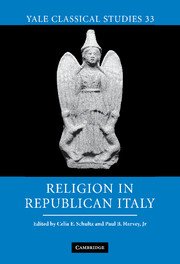Book contents
- Frontmatter
- Contents
- List of illustrations
- List of contributors
- Acknowledgments
- List of abbreviations
- Introduction
- Chapter 1 Reconsidering “religious Romanization”
- Chapter 2 In search of the Etruscan priestess: a re-examination of the hatrencu
- Chapter 3 Etruscan religion at the watershed: before and after the fourth century bce
- Chapter 4 Religious locales in the territory of Minturnae: aspects of Romanization
- Chapter 5 Religion and memory at Pisaurum
- Chapter 6 Inventing the sortilegus: lot divination and cultural identity in Italy, Rome, and the provinces
- Chapter 7 Hot, cold, or smelly: the power of sacred water in Roman religion, 400–100 bce
- Chapter 8 Religion and politics: did the Romans scruple about the placement of their temples?
- Chapter 9 Juno Sospita and Roman insecurity in the Social War
- Chapter 10 Beyond Rome and Latium: Roman religion in the age of Augustus
- Bibliography
- Index
Chapter 3 - Etruscan religion at the watershed: before and after the fourth century bce
Published online by Cambridge University Press: 08 January 2010
- Frontmatter
- Contents
- List of illustrations
- List of contributors
- Acknowledgments
- List of abbreviations
- Introduction
- Chapter 1 Reconsidering “religious Romanization”
- Chapter 2 In search of the Etruscan priestess: a re-examination of the hatrencu
- Chapter 3 Etruscan religion at the watershed: before and after the fourth century bce
- Chapter 4 Religious locales in the territory of Minturnae: aspects of Romanization
- Chapter 5 Religion and memory at Pisaurum
- Chapter 6 Inventing the sortilegus: lot divination and cultural identity in Italy, Rome, and the provinces
- Chapter 7 Hot, cold, or smelly: the power of sacred water in Roman religion, 400–100 bce
- Chapter 8 Religion and politics: did the Romans scruple about the placement of their temples?
- Chapter 9 Juno Sospita and Roman insecurity in the Social War
- Chapter 10 Beyond Rome and Latium: Roman religion in the age of Augustus
- Bibliography
- Index
Summary
By the beginning of the fourth century bce, the character of Etruscan religion had been established for centuries. Several generations later, though, the outward manifestations of popular belief and public cults had significantly changed, and appear (to us, in the light of surviving literary sources) to have drawn much closer to the cults of their Italic neighbors (or vice versa). Economic, social, and political forces in some ways prompted the change, but the situation was undoubtedly more complex and more evolutionary than it now appears. We must therefore rely on archaeological evidence to detect and assess that change; this chapter reviews that material, contrasting the archaeological and literary evidence.
Although Romans admired Etruscan religious expertise and credited the revealed scriptures of Etruria as sources for many Roman state rituals, the practices cited by ancient authors would be almost unknown if we had to judge from the material evidence alone. Apart from the Roman rites of city foundation, haruspicy and augury, the visible signs of Etruscan religion known to late Republican audiences were all tokens of the fourth century bce or later, when temples, votives, and rituals were already rather homogenized. Roman scholars of the first century bce still had access to Etruscan books and augural colleges (the ordo LX haruspicum, for example), but the great early sanctuaries (as at Veii) were in ruins or, as at Tarquinia (Pian di Civita and Ara della Regina), buried beneath fourth-century constructions.
- Type
- Chapter
- Information
- Religion in Republican Italy , pp. 62 - 89Publisher: Cambridge University PressPrint publication year: 2006
- 5
- Cited by



